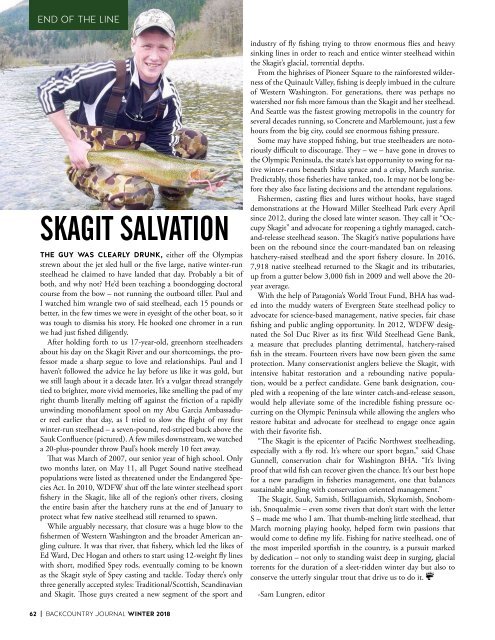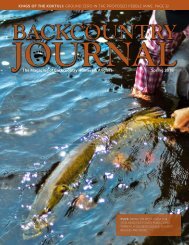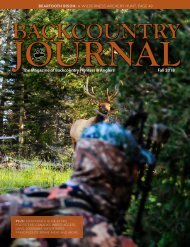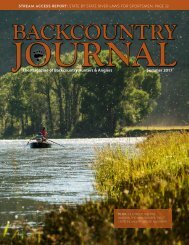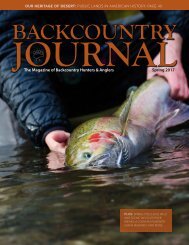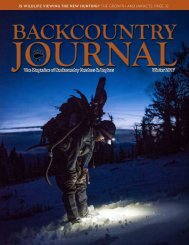BCJ_WINTER18 Digital Edition
You also want an ePaper? Increase the reach of your titles
YUMPU automatically turns print PDFs into web optimized ePapers that Google loves.
END OF THE LINE<br />
SKAGIT SALVATION<br />
THE GUY WAS CLEARLY DRUNK, either off the Olympias<br />
strewn about the jet sled hull or the five large, native winter-run<br />
steelhead he claimed to have landed that day. Probably a bit of<br />
both, and why not? He’d been teaching a boondogging doctoral<br />
course from the bow – not running the outboard tiller. Paul and<br />
I watched him wrangle two of said steelhead, each 15 pounds or<br />
better, in the few times we were in eyesight of the other boat, so it<br />
was tough to dismiss his story. He hooked one chromer in a run<br />
we had just fished diligently.<br />
After holding forth to us 17-year-old, greenhorn steelheaders<br />
about his day on the Skagit River and our shortcomings, the professor<br />
made a sharp segue to love and relationships. Paul and I<br />
haven’t followed the advice he lay before us like it was gold, but<br />
we still laugh about it a decade later. It’s a vulgar thread strangely<br />
tied to brighter, more vivid memories, like smelling the pad of my<br />
right thumb literally melting off against the friction of a rapidly<br />
unwinding monofilament spool on my Abu Garcia Ambassaduer<br />
reel earlier that day, as I tried to slow the flight of my first<br />
winter-run steelhead – a seven-pound, red-striped buck above the<br />
Sauk Confluence (pictured). A few miles downstream, we watched<br />
a 20-plus-pounder throw Paul’s hook merely 10 feet away.<br />
That was March of 2007, our senior year of high school. Only<br />
two months later, on May 11, all Puget Sound native steelhead<br />
populations were listed as threatened under the Endangered Species<br />
Act. In 2010, WDFW shut off the late winter steelhead sport<br />
fishery in the Skagit, like all of the region’s other rivers, closing<br />
the entire basin after the hatchery runs at the end of January to<br />
protect what few native steelhead still returned to spawn.<br />
While arguably necessary, that closure was a huge blow to the<br />
fishermen of Western Washington and the broader American angling<br />
culture. It was that river, that fishery, which led the likes of<br />
Ed Ward, Dec Hogan and others to start using 12-weight fly lines<br />
with short, modified Spey rods, eventually coming to be known<br />
as the Skagit style of Spey casting and tackle. Today there’s only<br />
three generally accepted styles: Traditional/Scottish, Scandinavian<br />
and Skagit. Those guys created a new segment of the sport and<br />
industry of fly fishing trying to throw enormous flies and heavy<br />
sinking lines in order to reach and entice winter steelhead within<br />
the Skagit’s glacial, torrential depths.<br />
From the highrises of Pioneer Square to the rainforested wilderness<br />
of the Quinault Valley, fishing is deeply imbued in the culture<br />
of Western Washington. For generations, there was perhaps no<br />
watershed nor fish more famous than the Skagit and her steelhead.<br />
And Seattle was the fastest growing metropolis in the country for<br />
several decades running, so Concrete and Marblemount, just a few<br />
hours from the big city, could see enormous fishing pressure.<br />
Some may have stopped fishing, but true steelheaders are notoriously<br />
difficult to discourage. They – we – have gone in droves to<br />
the Olympic Peninsula, the state’s last opportunity to swing for native<br />
winter-runs beneath Sitka spruce and a crisp, March sunrise.<br />
Predictably, those fisheries have tanked, too. It may not be long before<br />
they also face listing decisions and the attendant regulations.<br />
Fishermen, casting flies and lures without hooks, have staged<br />
demonstrations at the Howard Miller Steelhead Park every April<br />
since 2012, during the closed late winter season. They call it “Occupy<br />
Skagit” and advocate for reopening a tightly managed, catchand-release<br />
steelhead season. The Skagit’s native populations have<br />
been on the rebound since the court-mandated ban on releasing<br />
hatchery-raised steelhead and the sport fishery closure. In 2016,<br />
7,918 native steelhead returned to the Skagit and its tributaries,<br />
up from a gutter below 3,000 fish in 2009 and well above the 20-<br />
year average.<br />
With the help of Patagonia’s World Trout Fund, BHA has waded<br />
into the muddy waters of Evergreen State steelhead policy to<br />
advocate for science-based management, native species, fair chase<br />
fishing and public angling opportunity. In 2012, WDFW designated<br />
the Sol Duc River as its first Wild Steelhead Gene Bank,<br />
a measure that precludes planting detrimental, hatchery-raised<br />
fish in the stream. Fourteen rivers have now been given the same<br />
protection. Many conservationist anglers believe the Skagit, with<br />
intensive habitat restoration and a rebounding native population,<br />
would be a perfect candidate. Gene bank designation, coupled<br />
with a reopening of the late winter catch-and-release season,<br />
would help alleviate some of the incredible fishing pressure occurring<br />
on the Olympic Peninsula while allowing the anglers who<br />
restore habitat and advocate for steelhead to engage once again<br />
with their favorite fish.<br />
“The Skagit is the epicenter of Pacific Northwest steelheading,<br />
especially with a fly rod. It’s where our sport began,” said Chase<br />
Gunnell, conservation chair for Washington BHA. “It’s living<br />
proof that wild fish can recover given the chance. It’s our best hope<br />
for a new paradigm in fisheries management, one that balances<br />
sustainable angling with conservation oriented management.”<br />
The Skagit, Sauk, Samish, Stillaguamish, Skykomish, Snohomish,<br />
Snoqualmie – even some rivers that don’t start with the letter<br />
S – made me who I am. That thumb-melting little steelhead, that<br />
March morning playing hooky, helped form twin passions that<br />
would come to define my life. Fishing for native steelhead, one of<br />
the most imperiled sportfish in the country, is a pursuit marked<br />
by dedication – not only to standing waist deep in surging, glacial<br />
torrents for the duration of a sleet-ridden winter day but also to<br />
conserve the utterly singular trout that drive us to do it.<br />
-Sam Lungren, editor<br />
62 | BACKCOUNTRY JOURNAL WINTER 2018


